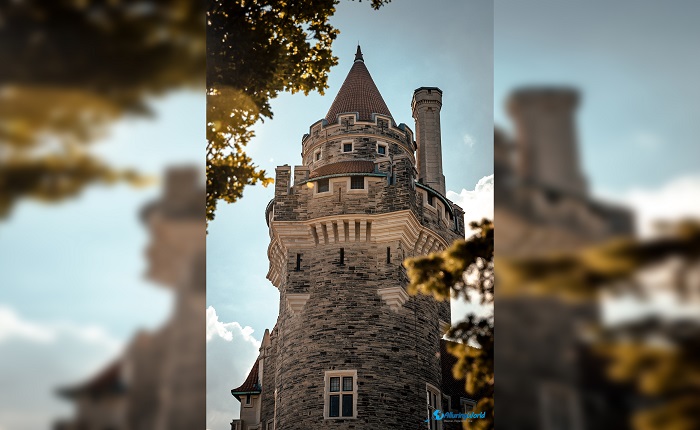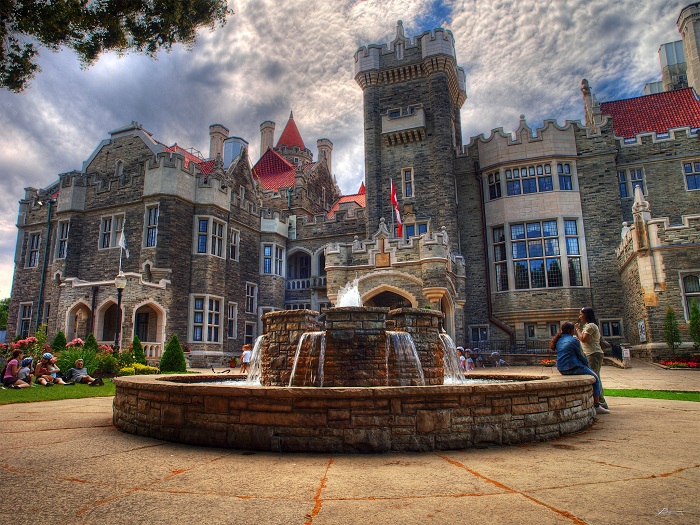Casa Loma is a Gothic Revival castle-style mansion and garden that is located in midtown Toronto, in the Province of Ontario, within the central part of Canada. As it is perched atop a hill in the heart of Toronto, within the charming neighborhood of The Annex, this majestic mansion stands as a symbol of opulence and historical significance that was commissioned by the wealthy financier and industrialist Sir Henry Pellatt, to serve as his residence.
The construction was from 1911 and it lasted through 1914 based on the vision of its commissioner, and the extensive work of the architect E. J. Lennox, who designed several other city landmarks.

As Casa Loma sits at an elevation of 140 m (460 ft) above sea level, 66 m (217 ft) above Lake Ontario, Sir Henry Pellatt’s vision for Casa Loma was inspired by European castles and his admiration for their grandeur, and it was built using the latest construction techniques of the time, including steel-reinforced concrete and electric lighting.

Sir Pellatt aspired to create a home that would surpass any other in Canada, showcasing his wealth and social status, which would further host esteemed guests and stand as a testament to his success in making this place of grandeur and hospitality. The construction of the majestic structure spanned over three years and required a workforce of nearly 300 skilled laborers.

The castle’s foundation is anchored in bedrock, while the exterior features magnificent grey-brown limestone, contributing to its regal appearance. Additionally, the interiors were meticulously crafted with fine materials, including walnut, oak, and marble, and in total, the construction cost escalated to approximately $3.5 million, a staggering sum during that time.

The architectural style that is featured on the building’s façade showcases a harmonious blend of various styles, predominantly Gothic Revival, with some Romanesque and Edwardian influences.

The castle boasts soaring towers, turrets, battlements, and majestic archways, all reminiscent of the medieval castles that inspired its creation, while one of the most important rooms that the interior contains is The Great Hall, which is an 18 m (60 ft) high room with intricate woodwork and splendid stained glass windows, making it the heart of the castle’s opulence.
The interior furthermore boasts luxuries like electricity, multiple bathrooms with hot and cold running water, an elevator, and central heating, something that was considered a luxury back in the time when it was built. Featuring 98 lavishly decorated rooms, including a grand ballroom, a library, a music room, and a solarium, as well as luxurious guest suites and servant quarters, Casa Loma was the place that everyone desired either to have for them or to stay in it and enjoy the excellent luxuries of the time.
In addition to this, the castle also has several secret passageways and tunnels. Moreover, as Casa Loma was completed just as the First World War was beginning, Sir Pellatt was using the castle, however, due to various business ventures that failed to deliver expected returns he was forced to sell the castle in 1923 after he fell on hard times.
After Sir Henry Pellatt’s departure, Casa Loma served various purposes, including a hotel, a war-time base for the Royal Canadian Navy, and even a popular nightspot during the Prohibition era, so that in 1937, the city of Toronto would purchase Casa Loma. Then the city took it upon itself and commenced a thorough restoration project to preserve this invaluable piece of history so that once completed it would open it to the public as a museum.

The castle is now one of Toronto’s most popular tourist attractions, being among one of the great Toronto’s history and architectural heritage structures, attracting over 650,000 visitors each year.

Today Casa Loma is an important landmark in Toronto’s history, as it serves as a reminder of the city’s Gilded Age, when wealthy industrialists built lavish homes to showcase their wealth, further providing insight into the opulent lifestyle of the Canadian elite during the early 20 century.
In popular culture, the castle was also used as a filming location, and has been featured in movies and television shows such as “X-Men: The Last Stand” and “The Handmaid’s Tale”. In conclusion, Casa Loma is a unique and fascinating building that is a testament to the vision of Sir Henry Pellatt, serving as a reminder of Toronto’s awe-inspiring architecture and rich history, while it continues to enchant and educate visitors while being cherished as a national treasure.







